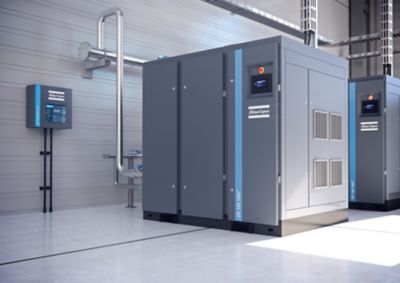March 27, 2024
There are compressed air pipes made of different materials to convey compressed air to the points of use. To choose the most convenient one, it is necessary to carry out an evaluation and know its characteristics. Today installers have five types of pipes for the distribution of compressed air.
Galvanised steel is perhaps the most common material used for carrying compressed air. It is a material that installation technicians are very familiar with. The galvanised coating extends the life of the pipe and protects it from rust.
However, there are some disadvantages to using this type of pipe, which include:
- It has a higher coefficient of frictionthan any other material, which increases the pressure drop in the network.
- It is prone to corrosion. Galvanizing deteriorates over time and scales cause blockages that can lead to accidents.
- It must be handled by qualified installerssince it requires knowledge of cutting, threading, and use of machinery. If welding is necessary, it must be done by an experienced welder.
- It is difficult to maneuver;and threaded or welded joints are prone to failure. As it is a heavy material, it requires greater resistancein the suspension and fixing methods.
The primary advantage of stainless steel is that there is no risk of corrosion or degradation inside or outside.
Some industries demand strict requirements for this pipe. This is the case in the pharmaceutical industry, hospitals, research laboratories, clean rooms, and healthcare facilities, where the recommended type of pipe is SS304L or SS316L stainless steel. Additionally, the NFPA has approved stainless steel for vacuum applications in healthcare facilities
Aluminium is anti-corrosive, lightweight and easy to handle. Other advantages of this pipe are:
- Pressure losses are reduced because its interior is smooth and resistant to corrosion, thus far surpassing galvanized air pipe in terms of starting efficiency and durability. For this reason, the cost of ownership is lower than other materials.
- The piping system is easily reconfigured if the facility grows in size or needs to be relocated.
This metal is corrosion-resistant and is easy to cut and weld. It is lightweight and has a wide range of accessories available, while being frequently used in plumbing.
Disadvantages:
- Both compression and solder joint systems in copper take more time and cost to install than aluminum systems.
- It has a coefficient of expansion almost double that of aluminum, so in large installations, more material is required to solve this problem.
Copper air pipes are primarily used in medical applications due to its microorganism-inhibiting properties and in small diameters because of its installation cost.
Plastic air pipes are cheap, corrosion-resistant, and easy to install. However, there are some contraindications to their use in compressed air distribution:
- Not all plastic pipes are suitable for compressed air distribution. The use of PVC pipe in any compressed air application is extremely dangerous and is not recommended by multiple associations and manufacturers.
- When air is compressed inside PVC pipe, the pipe can swell and explode under high pressure, releasing PVC debris outward in an uncontrolled manner.
- This type of pipe also deteriorates over time and becomes brittle, increasing the chance of a leak or explosion as it ages.
- Its use may result in a violation for the OSHA agency (Occupational Safety and Health Administration), both for the transportation of compressed air and gases.
Polyamide pipes are mainly used in smaller workshops with several pneumatic tools.
When designing a durable compressed air distribution system, more and more facilities are choosing aluminium compressed air piping due to its structural strength, light weight, and high corrosion resistance. Although the initial material cost is higher than galvanised pipe, the savings in installation labor will more than offset the difference in material cost.
A stainless steel pipe is recommended for plants using oil-free compressors to avoid corrosion problems and resulting downstream contamination. In the past, welding stainless steel was a time-consuming and expensive option. However, there are now stainless steel pressed air systems that can reduce installation costs to a fraction of what they were before.
To get the most out of your compressed air pipework, it is important to follow the manufacturers’ instructions and recommendations on how to install the system. Be sure to comply with all listed specifications and limitations for pressures and temperatures.

